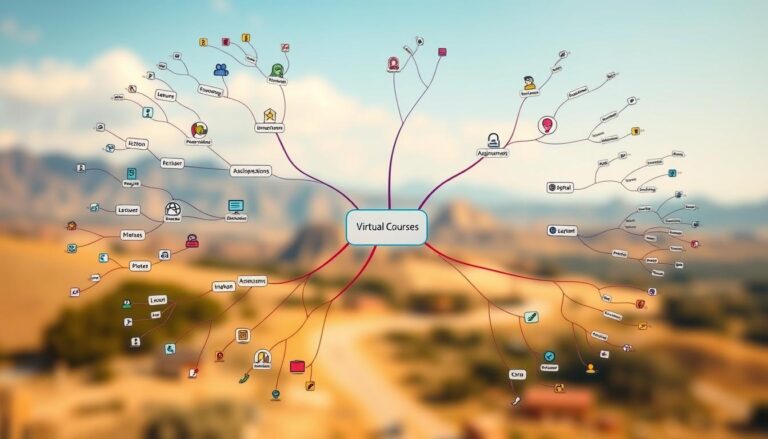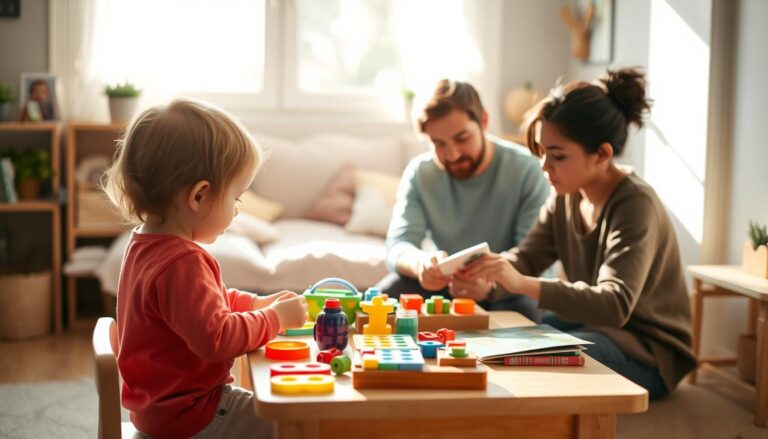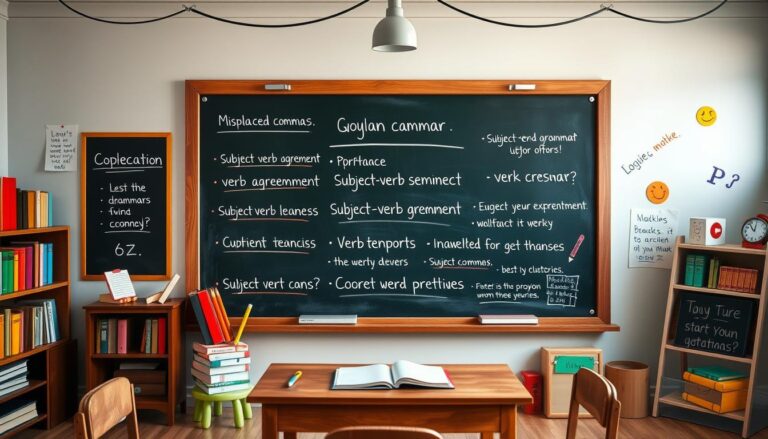Managing Multiple Ages in Home Pre-School
Have you ever wondered how children of different ages can thrive together in one learning space? At our program, we believe that blending children across ages fosters organic growth and creates a unique educational experience.
Inspired by Montessori principles, our approach focuses on developing each child’s potential. We create a structured yet flexible classroom where every child feels valued. This environment encourages social skills, emotional growth, and a love for learning.
Our program integrates academic and life skills, ensuring a well-rounded education. By using versatile materials, we cater to the needs of every child in the group. This method not only benefits the children but also strengthens family bonds.
Join us as we explore how a thoughtfully designed program can transform education for your family. Together, we can create a nurturing space where every child thrives.
Understanding the Foundation of Multi-Age Learning
The Montessori approach emphasizes the natural benefits of learning in a group with varying ages. This method fosters a unique environment where children grow together, blending skills and experiences. By understanding the foundation of multi-age learning, we can create spaces that nurture both academic and social development.
The Montessori Philosophy and Its Influence
Maria Montessori’s writings highlight the importance of mixed-age interactions. In a Montessori classroom, children of different ages learn side by side. This setup allows younger children to observe and learn from older peers. It also encourages older children to model positive behavior and take on leadership roles.
This philosophy promotes a harmonious learning community. It eliminates unhealthy competition and emphasizes individual growth. Each child progresses at their own pace, supported by the group dynamic. This approach fosters a love for learning and builds essential life skills.
Building a Cohesive Social Community
In a multi-age classroom, extended time together shifts the dynamic. Children develop a sense of care and shared responsibility. Older students mentor younger ones, fostering empathy and collaboration. Teachers play a crucial role in guiding these interactions, ensuring a positive and inclusive environment.
This setup nurtures essential skills like communication, teamwork, and problem-solving. It also strengthens social bonds, creating a supportive community.
Key Strategies for Managing Multiple Ages at Home
Creating a harmonious learning environment for children of varying abilities requires thoughtful planning. Drawing from Montessori methods, we focus on tailored instruction, observational planning, and flexible group settings. These strategies ensure every child thrives in a supportive and inclusive space.
Tailoring Learning Approaches Based on Age and Ability
Each child learns at their own pace, and our program reflects this understanding. We adjust activities to match the unique needs of every child. For example, younger children engage in sensory play, while older children tackle complex problem-solving tasks.
This approach not only supports individual growth but also fosters collaboration. Older children often mentor younger ones, reinforcing their own skills while building leadership qualities. This dynamic creates a balanced and enriching experience for everyone.
Establishing a Balanced Routine and Schedule
A well-structured routine is essential for managing multiple ages. Clear schedules help children feel secure and understand daily expectations. Visual aids, like charts with pictures and words, support younger children in following the routine independently.
We also incorporate regular observation to ensure no child is left behind. Teachers assess progress and adjust activities as needed. This flexibility allows us to meet the diverse needs of each child effectively.
| Strategy | Benefit |
|---|---|
| Tailored Instruction | Supports individual learning paces and abilities |
| Observational Planning | Ensures no child is left behind |
| Flexible Group Settings | Encourages collaboration and mentorship |
| Balanced Routine | Provides structure and security |
Creating an Engaging “mixed age preschool home” Environment
Designing a learning space that caters to children of different ages can be both rewarding and challenging. A well-organized environment supports independence, collaboration, and curiosity. By optimizing physical and learning spaces, we create a setting where every child thrives.
Optimizing Physical and Learning Spaces
Our environment is carefully designed to spark curiosity and meet the needs of every child. We organize the classroom into distinct zones, each tailored to specific activities. This setup encourages both individual exploration and group work.
Materials are chosen to support developmental stages. For example, younger children benefit from sensory tools, while older children engage with complex problem-solving tasks. This approach ensures that every child finds something meaningful to work on.
Flexibility is key. Our layout allows children to move freely between activities, fostering independence. Teachers observe and adjust the space to meet evolving needs, ensuring a balanced and engaging experience.
| Element | Purpose |
|---|---|
| Distinct Zones | Encourage focused activities and collaboration |
| Developmental Materials | Support individual learning needs |
| Flexible Layout | Promote independence and adaptability |
| Teacher Observation | Ensure the environment meets all needs |
Parents can recreate this environment at home by focusing on safety, inspiration, and warmth.
Leveraging Peer Learning and Leadership Opportunities
Leadership and empathy flourish when children learn from one another. In our program, we create opportunities for older children to mentor younger ones. This approach builds confidence and fosters a sense of community.
Encouraging Mentorship from Older Children
Older children naturally take on leadership roles in a Montessori classroom. They guide younger peers, reinforcing their own skills while teaching. This practice enhances their understanding and builds responsibility.
For example, an older child might help a younger one with a puzzle. This interaction strengthens both children’s abilities. It also creates a supportive learning environment where everyone thrives.
Fostering Empathy and Collaborative Skills
Peer-led teaching encourages empathy and teamwork. Older children learn to care for and support their younger classmates. Younger children, in turn, feel valued and included.
Collaborative activities, like group projects, further develop these skills. Each child contributes actively, learning to share ideas and solve problems together. This dynamic prepares them for future challenges.
| Benefit | Outcome |
|---|---|
| Leadership Development | Older children gain confidence and responsibility |
| Empathy Building | Children learn to care for and support others |
| Collaborative Skills | Teamwork and problem-solving are enhanced |
| Community Growth | A supportive and inclusive environment is created |
Fostering Individual Growth Through Adaptable Teaching Methods
Adapting teaching methods to suit each child’s unique needs is at the heart of our program. We focus on creating a learning environment where every child can thrive. By integrating observation-driven strategies, we ensure that every child’s development is supported.
Observation-Based Learning and Its Benefits
Regular observation is a cornerstone of our approach. Teachers carefully monitor each child’s progress to identify strengths and areas for growth. This practice allows us to tailor activities that align with their developmental stage.
For example, a child who excels in problem-solving might be given more complex tasks. Meanwhile, another child might benefit from additional support in social skills. This personalized attention ensures that no child is left behind.
Personalizing Activities to Meet Unique Needs
We believe that every child learns at their own pace. Our program uses hands-on materials and thoughtful work cycles to meet individual needs. Younger children might explore sensory tools, while older children engage in advanced problem-solving.
This approach not only supports academic growth but also fosters self-directed learning. Children are encouraged to explore their interests, building confidence and independence. For more insights, explore our Home E-Learning Pre-School program.
By combining structured routines with flexible activities, we create a balanced environment. This method ensures that every child feels valued and supported in their learning journey.
Conclusion
A well-structured learning environment brings out the best in every child, regardless of their stage of development. By blending varied groups, we create unique opportunities for growth and collaboration. Older children naturally take on leadership roles, mentoring younger peers and fostering empathy. This dynamic benefits everyone, building a strong sense of community.
Our strategies focus on balancing structure with flexibility, ensuring each child’s needs are met. We emphasize not just academic skills but also essential life attributes like resilience and teamwork. Families are invited to embrace these approaches, creating a space where every child thrives.
Together, we can nurture a learning environment that celebrates individuality and collective growth. Join us in shaping a brighter future for your family.







